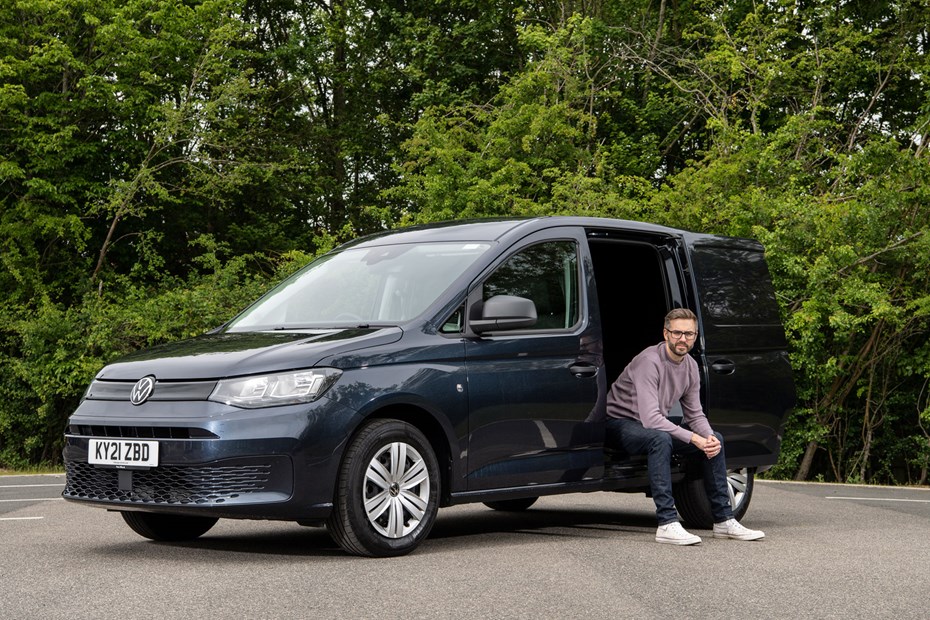Final report: Our long-term test verdict on the VW Caddy
It’s fair to say that the VW Caddy did a real tour of duty on its time with us, being driven by a wide range of people for a variety of reasons. Actually, the reasons weren’t that varied – it was generally because someone needed to move something that was too big to fit into a normal car. The items themselves might have been varied, but the person sending the polite note asking to borrow the Caddy generally had similar requirements.
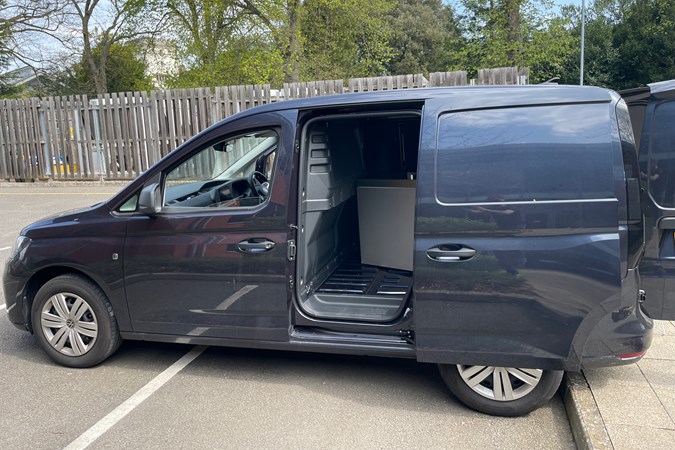
Accommodating car users
What is notable is that barely any of these part-time custodians of the Caddy were regular van users, but few came back with any comments on the sort of features that tend to be characteristic of commercial vehicles. The lack of visibility, the sparse nature of the cabin, the loud noise thrown up by the road and engine on the move. This means that the VW passed one of its sternest tests, by being a van that is not overly intimidating for car drivers to use.
Sure, there are solid rear doors, which is one of the biggest things to get over as a non-van user, but the standard-fit rear parking sensors go a long way to helping on that front. As ever, I welcome larger than average door mirrors, or ones that show up your blind spot that bit more, but there were no hairy moments to report on.
One downside of the Caddy going on its magical mystery tour of the country at the hands of my colleagues and with a wide variety of loads and jobs to deal with is the fact that recording fuel economy became a logistical nightmare. The tanks that it had while in my possession came out at around 54mpg, though, which is close enough to the official figure of 57.6mpg that I can’t really complain too much. And as Colin says below, he managed to get closer to 60mpg.
Tiny gripes
The praise for the practicality was almost universal in the Caddy’s time with us – not really a surprise as no-one had anything too heavy to ask of it, and some colleagues live in areas with tip managers that are more forgiving when it comes to allowing small vans through their gates. This meant that the VW’s comparatively low payload never became an issue.
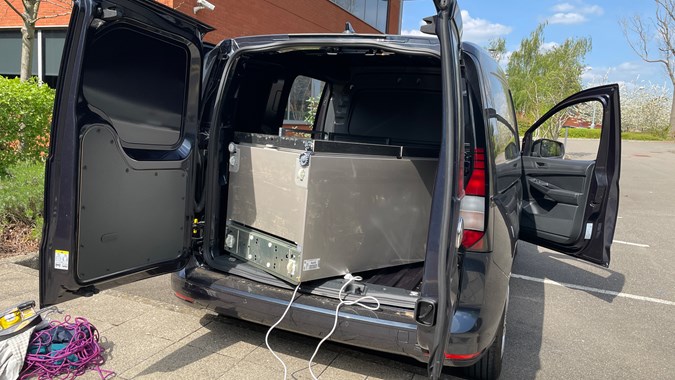
The one time where I came slightly unstuck was when a neighbour wanted to collect a fridge-freezer that was 1,650mm tall. According to the brochure the loading bay is 1,700mm long, a fact backed up by a tape measure. Unfortunately, I hadn’t accounted for the fact that it is only that long at the floor and there is an overhang of about 50mm half way up the bulkhead. This means the doors had to be held shut with ratchet straps and the fridge-freezer had to hang out slightly.
As the overhanging load was less than a metre, we didn’t have to mark it up, and just made sure that the door with the number-plate on was the one that was more closed.
Verdict
The small van class is a funny beast, in that it stands apart from almost all the others. This is because the contenders in it are newer than those in the medium and large sectors. The Caddy is, by many measures, an excellent van. However, it is up against some really strong contenders, in the form of the Toyota Proace City and the rest of the Stellantis small vans, the new Renault Kangoo and the Ford Transit Connect. Unlike some other van sectors there aren’t any ancient vehicles that are well overdue replacement.
As a result, inmost areas there is a rival that has the better of the Caddy – it has a smaller payload than others, it doesn’t have an electric version and there are ones with less confusing / irritating infotainment setups.
I’ve thoroughly enjoyed my time with the VW, but can see why you might opt for one of its rivals.
Report 4: The tour continues
By Colin Overland
Continuing the theme of people other than Tom Webster writing about Tom Webster’s car, and of those people using the Caddy for untypical purposes, I’ve been using it mostly as a way of chauffeuring friends and family around the country.
That’s not all I’ve done. Of course I’ve also taken garden waste and bits of old shelving to the tip, and I’ve taken bicycles to be repaired, and I’ve done plenty of shopping. Those trips have all served as reminders of the obvious: that even though the Caddy has a car-size footprint, the fact that it has only two seats means the cargo area is huge, and that cargo area is designed to be filled to the top. It makes even big cars, and van-based cars, seem extremely compromised as load-carriers. It’s not just the capacity. It’s also that in a van there are no vulnerable bits of upholstery that you need to worry about. Just sling it all in. Yes, the paintwork in the back gets scratched; it’s a van.
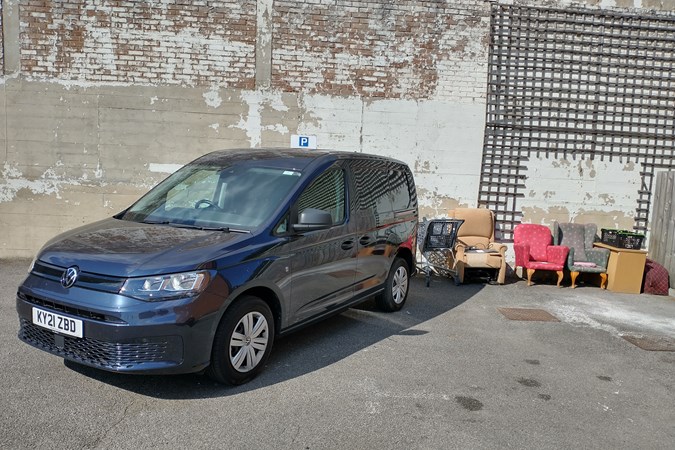
No point moaning about the absence of fancy infotainment and luxury features; it’s a van. And given that VW’s infotainment is generally not great at the moment, that’s a blessing. And the absence of drive modes to fiddle with is a good thing. They’re really not necessary when the fundamentals are so well sorted.
I’ve found the chauffeuring journeys quite eye-opening. I’ve been surprised how loud the Caddy is when you’re trying to chat naturally with your passenger. It’s a reminder of how well insulated regular cars are. The Caddy’s quite boomy even at modest speeds, and very boomy at higher speeds, so you find yourself shouting, or if you’re on your own turning the audio volume up, but that only really works for music – the spoken word just gets absorbed into the thrumming of the steel body.
As previously noted by other drivers, the suspension is clearly set up for loads. So when it’s just the two of you and a couple of rucksacks and tents, it’s a bit jittery and bouncy on some surfaces. Nothing too disturbing, but again it’s a reminder of how well set-up most cars are, at least for lighter loads.
But these trips, adding up to a couple of thousand miles, have given a chance for the Caddy to show how economical it can be. You don’t need to be going very steadily for it to approach 60mpg.
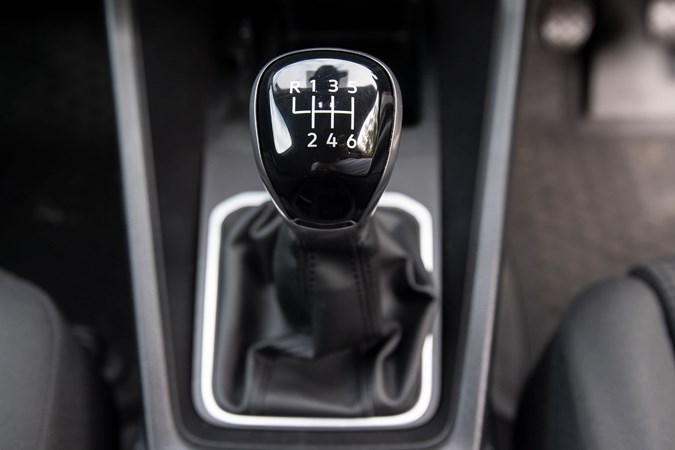
And then there are the solo trips. After dropping one of my kids off at a festival on the other side of the country, I had the pleasure of a summer’s evening return journey when I seemed to have the roads to myself. The Caddy is not a fast car, and it doesn’t have sports-car precision, but it’s highly responsive and engaging in its own way. The steering, gearchange and throttle response make ring roads and country lanes most enjoyable, and overtaking is a blast.
It runs out of puff before you hit three figures, but the in-gear acceleration is very usable, and you sometimes find yourself going round a roundabout twice just for the hell of it. Get it in the sweet spot at around 2,500rpm, the steering weights up nicely, and you feel wonderfully connected to the Caddy. And then you hit a clumsy bit of road repair, and the Caddy’s suspension passes all of the shock on to the cabin and it feels like a couple of fillings are about to fall out…
Report 3: Tipping point
Once again I’ve managed to farm out the update for my Caddy, this time to new cars editor Alan Taylor-Jones who’s carrying out some home renovations. I’ll let him pick up the story….
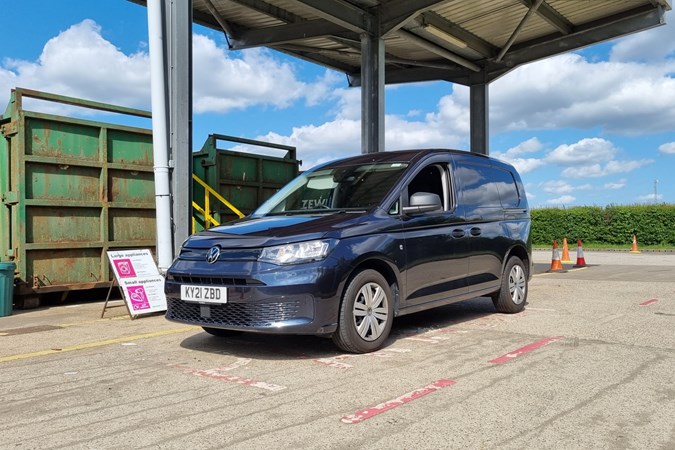
Going the distance
Don’t worry, this isn’t just another report on how much stuff I could fit in the Caddy, I promise I did more than schlep a load of stuff to the tip. Instead, I made full use of its long-distance economy and the considerable amount of diesel Tom had left in it to attend a launch a couple of hours away.
This was a great opportunity to test the Caddy out unladen, a state that often brings out the worst in a van’s comfort. Predictably there was a little bit of bounce at the rear, but it certainly didn’t cause a great deal of discomfort even over rippling Fenland roads and proved a good companion on smoother dual carriageways.
Even travelling at the legal limit, over 50mpg was easily achievable (no doubt helped by the empty box behind me) and it didn’t disgrace itself on twistier roads, either. Precise steering with reassuring weight means it’s easy to place on the road, while there’s plenty of grip so you can make good progress. You won’t have fun, although you’re unlikely to be late for a job.
The lack of Android Auto and Apple CarPlay was something of an annoyance, although unlike Murray I decided against using the built-in nav. Instead I found my mobile slotted quite nicely into a cupholder leaving me to follow the instructions over Bluetooth.
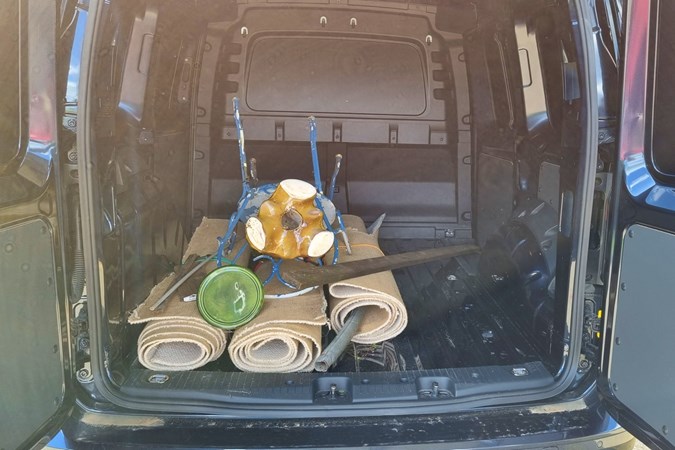
Getting down to business
So, it performed admirably as a car, what about as a van? Well, in our infinite wisdom we purchased a house that’s a bit of a project whilst also having our first child. With him now a few months old we desperately needed to sort his bedroom out. As the state of the existing carpet was best described as grim, possibly with a choice expletive at the start, a van seemed like the best bet for a tip run.
Thankfully our local recycling centre is pretty easy going when it comes to commercial vehicles with no special permits required. The fairly meagre load proved no issue, the carpet folding with other detritus getting chucked on top. Well, I say chucked. In reality it was carefully stacked as the load bay had no protective ply liner, something that I’d want to option.
Short stuff
I’d also want some sort of through loading system, as it quickly became apparent that a trip to Jewsons to get timber would require a change of car or some bungee straps. I’ve driven Transits that have a handy door in the lower bulkhead to allow longer items to slide below the front seats, so it’s a shame this particular Caddy didn’t have such a feature.
Instead, it was my BMW 2 Series Active Tourer that proved far handier for longer loads on account of its folding rear seat and open cabin. Still, I suppose if that is an issue you’d just select the longer Caddy variant.
Report 2: A trip to Ikea
One of the joys of living with a van is that it gives your popularity a huge boost. I’m never short of people checking in to see how I am/how my weekend was/etc. This is normally short lived and they swiftly get around to what they really want – to borrow the van. The colleague in need this time is Parkers deputy editor, Murray Scullion, who was moving house. Over to Murray…
Space for sleeping
Is a house move complete without a frantic run to Ikea to pick up a bed and bedframe before you move in? You know, so you actually have somewhere to sleep? Luckily for me, a VW Caddy is just about long enough for both items, even with the full width bulkhead. Full points so far.

I was also impressed with the low load lip with plastic surrounding, which meant I could simply glide heavy items into the back of the van like a curling champion.
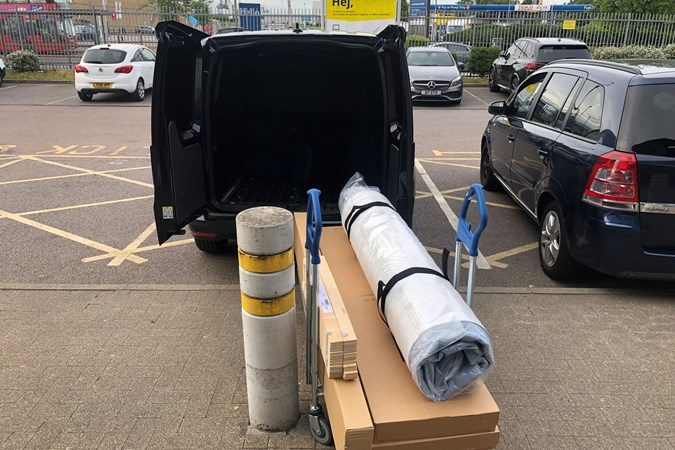
The van bit, then, is spot on. As is the engine. I know diesels aren’t all that fashionable at the moment, but that huge slug of low-down torque is just what a van needs. It’s a bit noisy, but then not really that bad compared with other vans, and the manual gearbox is great too. Easy shifting, long ratios and the stop-start is integrated in a manner which you get used to quickly. It seemingly knows just when to kick in or not. Peugeot if you’re reading this, please borrow a Caddy for a day.
Cabin shortfalls
Like with the VW ID.3 I ran for six months the Caddy has individual armrests. I covered more than 300 miles in this van and couldn’t find much to complain about in terms of comfort, either empty or with a full load of Ikea or house detritus stuffed into the back.
Unfortunately, the seats are where the ID.3 and Caddy stop sharing similarities. Theoretically the cars have very similar infotainment setups, but I found the one in the van to be at least 10 times more annoying. Booting up takes forever, the controls are dimwitted, this particular one doesn’t come with Apple CarPlay or Android Auto and the sat-nav has a mind of its own. And a slow one at that.
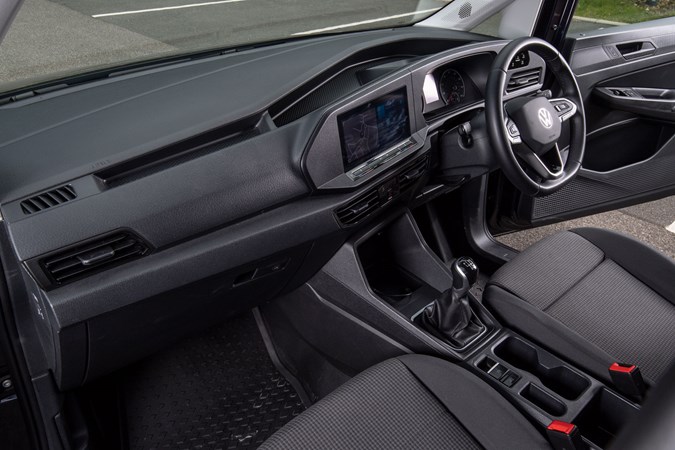
No matter what postcode you tap in, it doesn’t have a scooby what the road is called. This is annoying when you go to the previous destinations tab and just see a list of coordinates staring back at you. Unless you remember how many times you’ve used the nav previously, you’ll need to enter the address again.
This wouldn’t be so bad, but the nav itself is painfully slow at relaying instructions to you, often giving you a roundabout exit number while you’re already on the thing, not before it.
Oh, and the aircon doesn’t work (although this is now on Tom’s list to get sorted). And even if it did, it won’t let you select a specific temperature, it just offers a sliding scale of hot and cold, like you used to get in the Eighties. Except in the Eighties you at least had a physical slider you gripped with your thumb and index finger, rather than a touchpad which you kind of poke and slide your middle finger across.
Basically I loved the front (engine, gearbox) and rear (huge square box with good lip) but found the middle bit (the place you actually spend time in) frustrating.
Report 1: All change, thank you
The contenders in the small van sector seem to, above all else, shout about two major attributes – how much stuff they can carry relative to their size and just how wonderfully car like they are to drive.
The former claim is easily proven or not – the numbers don’t lie after all – but the latter is much more down to personal interpretation. The previous generation – the fourth – might well have been car like to drive when it first launched but by its time finally came it was a long way shy of even the most basic of cars.
The new version revives that promise and some. It is based on the same platform as a large chunk of VW’s passenger cars, it has a hugely modernised cabin and a smart array of tech and touch-sensitive controls inside and out.
To fully ascertain whether living with a Caddy is comparable to doing so with a car we’ve started using one as our daily transport.
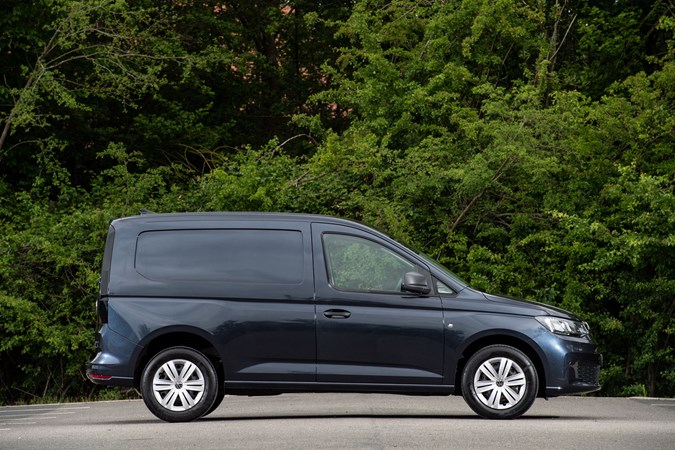
Practicality first
For all the guff I’ll no doubt spout about the driving experience, the luxurious cabin, the tech, the ride etc etc, a van still must be a practical tool first and foremost.
This is one area where the Caddy struggles to match up to the rivals, particularly the ever-more ubiquitous Stellantis vans. The likes of the Citroen Berlingo/Peugeot Partner/Toyota Proace City/Vauxhall Combo Cargo all boast payloads at or around 1,000kg, but the Caddy’s is a much more modest 648kg, which sounds pretty pitiful by comparison.
But who really needs to carry that much in a small van on a regular basis anyway?
The basic equipment is well geared towards practicality – you get six lashing rings, an interior light, solid rear doors and, crucially, a solid bulkhead. As well as boosting security, this also greatly helps the latest Caddy improve over its predecessor in a crucial area – noise.
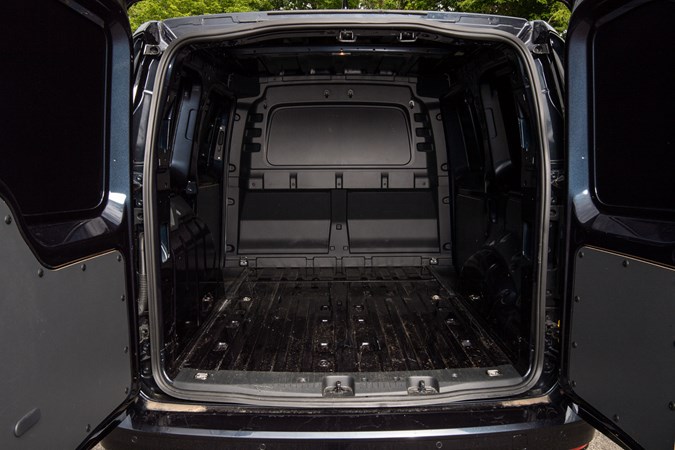
The level of road, wind and engine noise from a van is, in my view, what really contributes to how bearable it is to live with on a daily basis and how much you might or might not want to jump in for those personal trips out of working hours. You might tolerate a noisy working environment, but you want some peace and quiet come the weekend.
Thankfully, the latest Caddy has made leaps and bounds on this front going by the evidence so far. A commercial vehicle with a noise-amplifying loading bay is always going to be noisier than something filled with lots of soft seats and extra insulation, so it doesn’t make the transition to car like, but it is indeed a move in the right direction.
What’s it going to do?
The version we have is about as middle-of-the-road as you can get. It is the mid-spec Commerce Pro trim, with barely anything added. The only extras are the Discover Media DAB+ navigation system with 10-inch screen and the blue metallic paint, which add £1,160 and £530 to the price (before VAT.)
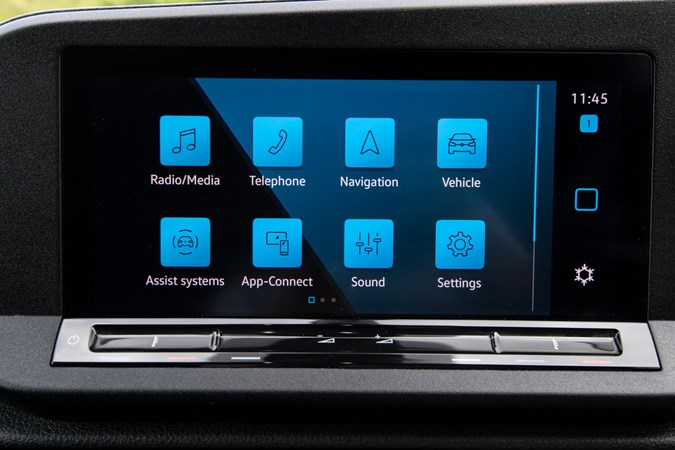
The rest of the kit is all part of the Commerce Pro package. This includes the lockable glovebox that is part of a generous interior storage setup, the body-coloured bumpers and door handles that make it look smarter than a mid-level van often does and the excellent level of safety kit that, excellently, includes an airbag for both driver and passenger.
The only real indulgence we’ve gone for is the engine, which, with 122hp, is the more powerful of those on offer. This has so far been a real bonus on the 50-plus mile commute to the office. This largely A-road affair has suited the Caddy’s economy so far, returning within 5% of the official figure. Here’s hoping it continues to behave when we have more demanding jobs lined up in the coming weeks.
Intimidating for the unconverted?
Many of those demanding jobs will be ones carried out by my colleagues, who have house moves, domestic clearances and various exciting purchases lined up. This means lending the keys to my commercial vehicle to people who are more used to driving cars.
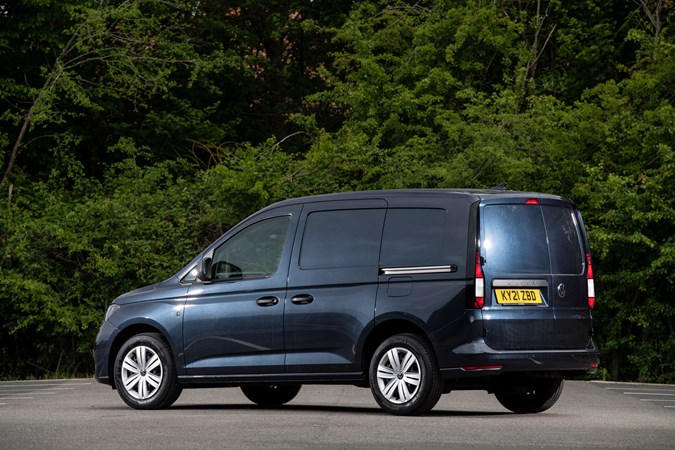
This is not meant as a slight on my colleagues, who are a sensible lot, but I want to know how easy it is for people who don’t normally drive vans to jump behind the wheel of the Caddy. Getting into something with visibility compromised by a lack of windows at the rear and sides is a potentially intimidating prospect. I do it all the time, so I want to know how they get on.
- List price: £23,340 (ex VAT, OTR)
- Engine: 2.0-litre turbo diesel four-cylinder, 122hp, 320Nm
- Transmission: six-speed manual, front-wheel drive
- Miles so far: 1,050
- Claimed fuel economy: 57.6mpg
- Actual fuel economy: 54.9mpg
Just so you know, we may receive a commission or other compensation from the links on this website - read why you should trust us.


